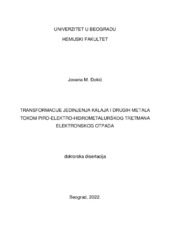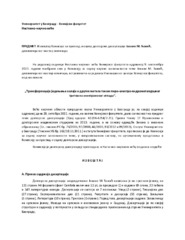Приказ основних података о дисертацији
Transformacije jedinjenja kalaja i drugih metala tokom piro-elektro-hidrometalurškog tretmana elektronskog otpada
Transformations of tin and associated metal compounds during pyro-electrohydrometallurgical treatment of electronic waste
| dc.contributor.advisor | Jovančićević, Branimir | |
| dc.contributor.other | Brčeski, Ilija | |
| dc.contributor.other | Kamberović, Željko | |
| dc.creator | Đokić, Jovana M. | |
| dc.date.accessioned | 2023-02-24T19:43:50Z | |
| dc.date.available | 2023-02-24T19:43:50Z | |
| dc.date.issued | 2022-09-28 | |
| dc.identifier.uri | https://eteze.bg.ac.rs/application/showtheses?thesesId=8964 | |
| dc.identifier.uri | https://fedorabg.bg.ac.rs/fedora/get/o:28028/bdef:Content/download | |
| dc.identifier.uri | https://plus.cobiss.net/cobiss/sr/sr/bib/108346633 | |
| dc.identifier.uri | https://nardus.mpn.gov.rs/handle/123456789/21241 | |
| dc.description.abstract | U ovoj doktorskoj disertaciji prikazani su naučni rezultati proučavanja hemijskih reakcija transformacije jedinjenja metala koristeći realne uzorke otpadnih štampanih ploča (OŠP). Za proučavanje su odabrana tri reakciona sistema: i) luženje, cementacija i elektrodepozicija za sukcesivno dobijanje Sn, Cu, Ag, Pb i Au, ii) transformacija metastanatne kiseline u rastvorna jedinjenja kalaja iz čvrstih proizvoda piro-elektrometalurškog tretmana OŠP, i iii) kontrola raspodele kalaja i pratećih metala u sistemu tečno-tečne ekstrakcije iz elektrolita. Fizičko-hemijskom karakterizacijom utvrđena je složenost ulaznih materijala i proizvoda u pogledu hemijskog i faznog sastava, veličine i morfologije. Termodinamičkom analizom inicijalno proučavanih sistema utvrđeni su hemijski potencijali reakcija, stabilnost i ravnoteža odabranih hemijskih vrsta. Utvrđeni su optimalni reakcioni uslovi u funkciji koncentracije i vrste kiseline, oksidacionog sredstva, temperature, odnosa faza, brzine mešanja, vremena trajanja procesa, napona na ćeliji i gustine struje. Efikasno i selektivno, luženjem te elektrodepozicijom dobijeno je 92,4% Cu, hloridnim taloženjem 98,5% Pb i 96,8% Ag i redukcionim taloženjem preko 99% Au u odnosu na njihovu početnu masu u uzorku. Kalaj (55,4%) je separacijom faza luženja dobijen u obliku visoko stabilne metastanatne kiseline, uz otežanu kontrolu mehanizma. Proučeni su reakcioni uslovi rastvaranja metastanatne kiseline – koncentracija HCl, temperatura, vreme trajanja procesa, nivo hidratacije uzorka, učešće redukcionog sredstva, sulfatnih jedinjenja i metala nečistoća. Sulfatna jedinjenja imaju inhibitorski efekat a učešće jakog redukcionog sredstva (Mg0) u kiselim hloridnim uslovima sredine (6 mol/dm3 HCl), kroz formiranje intermedijera i oslobađanje vodonika u reakciji, od presudnog su značaja za visoku efikasnost procesa (99%). U sistemu tečno-tečne ekstrakcije iz elektrolita, selektivnost zavisi od vrste, koncentracije i udela organske faze u sistemu a koncentracija H+ jona je od presudnog značaja za efikasnost. Ispitivanjem uticaja hemijske vrste aktivnog centra ekstrakcionog sredstava utvrđeno je da razgranati aldoksim ima preimućstvo nad aldoksim/ketoksim smešom, modofikovanom ili ne. Pri koncentraciji aldoksimskog ekstrakcionog sredstva od 30 vol.%, odnosu faza 3, vremenu kontakta od 10 min i pH od 1,5 odnosno primenom 180 g/dm3 H2SO4, odnosom faza 2, vremenom kontakta od 5 min u suprotnom procesu, se postiže hemijska kontrola kalaja u sistemu. U rafinatu je zadržano 90% ulazne koncentracije jona kalaja a kvantitativno u ekstratu. Postignuto je i selektivno izdvajanje jona bakra iz hemijski složenog sistema, a prevashodno u prisustvu visoke koncentracije jona gvožđa. Urađeni su laboratorijski testovi na uvećanom nivou, konstruisan dijagram raspodele elemenata i dat predlog tehnološke šeme. Na osnovu svega iznetog, zaključeno je da: i) integralnim hidrometalurškim pristupom moguće je efikasno i selektivno izdvojiti Cu, Pb, Ag i Au iz granulata OŠP ali da je u slučaju kalaja otežana kontrola mehanizma rastvaranja; ii) pri reakcionim uslovima definisanim u ovoj disertaciji moguća je efikasna transformacija metastanatne kiseline u rastvorna kalajna jedinjenja; iii) aldoksimsko ekstrakciono sredstvo omogućava kontrolu raspodele kalaja i jona metala nečistoća u sistemu tečno-tečne ekstrakcije iz elektrolita složenog hemijskog sastava. | sr |
| dc.description.abstract | The scientific results of the study of metal compound chemical reactions transformations, using real samples of waste printed circuit boards (WPCBs) are presented in this doctoral dissertation. Three reaction systems were selected for the study: i) leaching, cementation, and electrodeposition for consecutive recovery of Sn, Cu, Ag, Pb, and Au, ii) transformation of metastannic acid into soluble tin compounds from solid products of pyro-electrometallurgical treatment of WPCBs, and iii) distribution control of tin and accompanying metals from the electrolyte by the solvent extraction process. The complexity of input materials and products in terms of chemical and phase composition, size, and morphology is determined by physical-chemical characterization. The reaction's chemical potentials, stability, and equilibrium of selected chemical species are determined by thermodynamic analysis of the initially studied systems. The optimal reaction conditions as a function of acid concentration and type, oxidizing agent, temperature, solid to liquid phase ratio, stirring rate, process time, electrolytic cell voltage, and current density were examined. Efficiently and selectively, 92.4% Cu was obtained by leaching and electrodeposition, 98.5% Pb and 96.8% Ag by chloride precipitation, and over 99% Au by reduction precipitation. By separation of the leaching phases, tin was obtained (55.4%) as highly stable metastannic acid, revealing difficult mechanism control. Reaction conditions for metastannic acid dissolution - HCl concentration, temperature, process time, sample hydration level, participation of reducing agent, sulfate compounds, and metal impurities - were studied and determined. Sulfate compounds have an inhibitory effect and the participation of a strong reducing agent (Mg0) in chloride acid conditions (6 mol/dm3 HCl), through the formation of reaction intermediates and the hydrogen release, are crucial for high process efficiency (99%). In a solvent extraction system, process selectivity depends on the type, concentration, and fraction of the organic phase in the system. The concentration of H+ ions is crucial for Cu extraction efficiency. By determining the influence of the chemical type of extraction reagents' active center it was found that branched aldoxime has an advantage over aldoxime/ketoxime mixture, regardless of the presence of modifiers. Optimized extraction (aldoxime concentration of 30 vol.%, phase ratio 3, 10 min contact time, and pH 1.5) and re-extraction parameters (180 g/dm3H2SO4, phase ratio 2, 5 min contact time) allowed chemical control of tin: 90% of the input were retained in the raffinate but quantitatively in the extract. Selective separation of copper ions was also achieved, primarily in the presence of a high concentration of Fe2+/3+ ions. Defined reaction parameters were tested at a scaled-up laboratory level, an elements distribution diagram was constructed, and the proposal of the technological scheme was given. According to the stated, it was concluded that: i) integrated hydrometallurgical approach enables efficient and selective extract Cu, Pb, Ag, and Au from waste PCBs granulate, but that in the case of tin it is difficult to control the reaction mechanism; ii) under the reaction conditions defined in this dissertation, efficient metastatic acid transformation into soluble tin compounds is enabled; iii) extraction agent with aldoxime type of active center enables tin and metal ions impurities distribution control by solvent-extraction from electrolyte of complex chemical composition. | en |
| dc.format | application/pdf | |
| dc.language | sr | |
| dc.publisher | Универзитет у Београду, Хемијски факултет | sr |
| dc.rights | openAccess | en |
| dc.rights.uri | https://creativecommons.org/licenses/by-nc/4.0/ | |
| dc.source | Универзитет у Београду | sr |
| dc.subject | metali | sr |
| dc.subject | metals | en |
| dc.subject | reciklaža | sr |
| dc.subject | otpadne štampane ploče | sr |
| dc.subject | kalaj | sr |
| dc.subject | metastanatna kiselina | sr |
| dc.subject | tečnotečna ekstrakcija | sr |
| dc.subject | recycling | en |
| dc.subject | WPCBs | en |
| dc.subject | tin | en |
| dc.subject | metastannic acid | en |
| dc.subject | solvent extraction | en |
| dc.title | Transformacije jedinjenja kalaja i drugih metala tokom piro-elektro-hidrometalurškog tretmana elektronskog otpada | sr |
| dc.title.alternative | Transformations of tin and associated metal compounds during pyro-electrohydrometallurgical treatment of electronic waste | en |
| dc.type | doctoralThesis | |
| dc.rights.license | BY-NC | |
| dc.identifier.fulltext | http://nardus.mpn.gov.rs/bitstream/id/149757/Disertacija_13276.pdf | |
| dc.identifier.fulltext | http://nardus.mpn.gov.rs/bitstream/id/152673/Referat.pdf | |
| dc.identifier.rcub | https://hdl.handle.net/21.15107/rcub_nardus_21241 |



